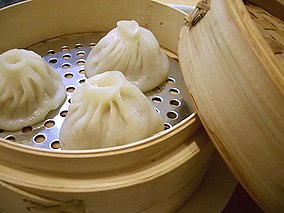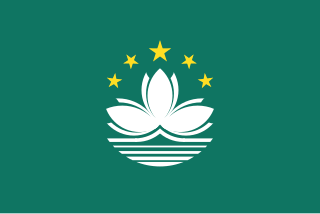
Macau or Macao is a special administrative region of the People's Republic of China. With a population of about 680,000 and a land area of 32.9 km2 (12.7 sq mi), it is the most densely populated region in the world.
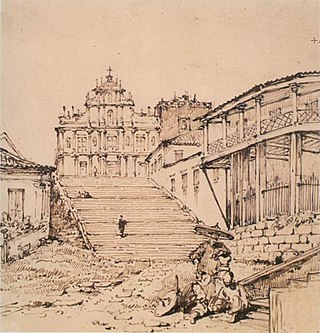
Macau is a special administrative region (SAR) of the People's Republic of China. It was leased to Portugal in 1557 as a trading post in exchange for a symbolic annual rent of 500 tael. Despite remaining under Chinese sovereignty and authority, the Portuguese came to consider and administer Macau as a de facto colony. Following the signing of the Treaty of Nanking between China and Britain in 1842, and the signing of treaties between China and foreign powers during the 1860s, establishing the benefit of "the most favoured nation" for them, the Portuguese attempted to conclude a similar treaty in 1862, but the Chinese refused, owing to a misunderstanding over the sovereignty of Macau. In 1887 the Portuguese finally managed to secure an agreement from China that Macau was Portuguese territory. In 1999 it was handed over to China. Macau was the last extant European territory in continental Asia.
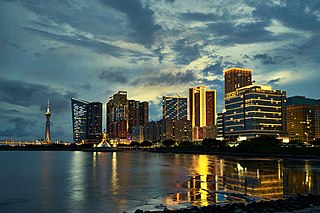
The economy of Macau is a highly developed market economy. Macau's economy has remained one of the most open in the world since its handover to China in 1999. Apparel exports and gambling-related tourism are mainstays of the economy. Since Macau has little arable land and few natural resources, it depends on mainland China for most of its food, fresh water, and energy imports. Japan and Hong Kong are the main suppliers of raw materials and capital goods. Although Macau was hit hard by the 1997–98 Asian financial crisis and the early 2000s recession, its economy grew approximately 13.1% annually on average between 2001 and 2006. Macau is a full Member of the World Trade Organization. Public security has greatly improved after handover to the People's Republic of China. With the tax revenue from the profitable gambling industry, the Macau government is able to introduce the social welfare program of 15 years of free education to all Macau citizens. In 2015, Macau's economy saw a sharp decrease due to the reduced spending by visitors from Mainland China since the Anti-corruption campaign under Xi Jinping.

Transport in Macau includes road, sea, rail and air transport. Road transport is the primary mode of transport within Macau, although a new rail system opened in December 2019 serving the areas of Taipa and Cotai. The main forms of public transport are buses and taxis.

Taipa is an area in Macau, connected to Coloane through the area known as Cotai, which is largely built from reclaimed land. Located on the northern half of the island, Taipa’s population is mostly suburban. Administratively, the boundaries of the traditional civil parish Freguesia de Nossa Senhora do Carmo are mostly coterminous with that of the former Taipa Island, except for a portion of the parish that lies on the island of Hengqin (Montanha), housing the campus of the University of Macau.

Coloane is the southernmost area in Macau, connected to Taipa through the area known as Cotai, which is largely built from reclaimed land. Known as “Lou Wan” in Cantonese, Coloane forms the southern part of Macau. Its population consists of several settlements dotted around the parish, such as Vila de Coloane, Hac Sa, Ká-Hó, and Cheoc Van. Administratively, the boundaries of the traditional civil parish of São Francisco Xavier are coterminous with that of Coloane.

The Macau Peninsula is the historical and most populous part of Macau. It has an area of 8.5 square kilometers (3.3 sq mi) and is geographically connected to Guangdong Province at the northeast through an isthmus 200 meters (660 ft) wide. The peninsula, together with downtown Zhuhai, sits on an island separated from the continent by distributaries of the Pearl River. The Border Gate was built on the northern isthmus. At the south, the peninsula is connected to Taipa Island by three bridges, the Friendship Bridge ; the Macau-Taipa Bridge ; and the Sai Van Bridge . The longest axis extends 4 kilometers (2.5 mi) from the Border Gate to the southwestern edge, Barra (媽閣嘴). There is a western "Inner Harbor" (內港) paralleled by an "Outer Harbor" (外港) to the east. The 93 meters (305 ft) Guia Hill (松山) is the highest point on the peninsula, which has an average elevation of 50 to 75 meters. Many coastal places are reclaimed from the sea. The Historic Centre of Macau, which is entirely on the Macau Peninsula, became a World Heritage Site in 2005.

Gambling in Macau has been legal since the 1850s when the Portuguese government legalised the activity in the autonomous colony. Since then, Macau has become known worldwide as the "Gambling capital of the world". It is the only place in China where casino gambling is legal.

Hengqin is an island that lies mostly in Zhuhai, a prefecture-level city and special economic zone in Guangdong Province of the People's Republic of China. It has a population of about 3,000. Parts of Hengqin are leased to Macau by the State Council of the People's Republic of China, starting from 2009, mostly to house the new campus of the University of Macau. In the leased parts of the island, Macau law applies.
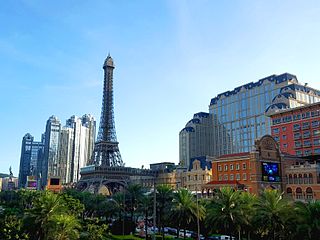
Cotai is a 5.2-square-kilometer (2.0 sq mi) piece of reclaimed land on the top of the Seac Pai Bay between Taipa and Coloane islands in Macau that has connected two independent islands since 2005. The name, which is a portmanteau of Coloane and Taipa, can also refer to the island formed by the reclaimation. In the second sense, the Special Administrative Region of Macau now consists of the Macau Peninsula, plus Cotai Island, about a mile to the south.

The Venetian Macao, is a hotel and casino resort in Macau, China owned by the American Las Vegas Sands company. The 39-story structure on Macau's Cotai Strip has 10,500,000-square-foot (980,000 m2) of floor space, and is modeled on its sister casino resort The Venetian Las Vegas. It is the largest casino in the world, the largest single structure hotel in Asia, and the tenth-largest building in the world by floor area.
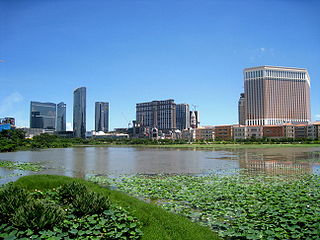
The Cotai Strip is a strip, known mostly for its hotel-casinos in the central area of Cotai, Macau. The term was first coined by Las Vegas Sands Corporation in reference to its construction of a strip.
The Sociedade de Turismo e Diversões de Macau, SA is a company in Macau owned by the family of Stanley Ho. Historically, it held a monopoly to Macau's gambling industry as the only licensee for casinos. In 2002, the government of Macau began issuing more licenses and the monopoly was broken. Still, of the 41 operating casinos in Macau, 22 are owned by STDM, as of 2019.
Articles related to Macau include:

The following outline is provided as an overview of and topical guide to Macau:
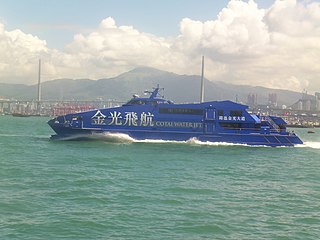
Cotai Water Jet is a company that operates high-speed ferry services between the special administrative regions of Macau and Hong Kong. It is one of the two companies operating high-speed ferry services between the two territories – the other one being TurboJET.

Wanzai, Small Hengqin and Great Hengqin are three islands located to the west of the Macau Peninsula and the Macau islands of Taipa and Coloane that were under Portuguese influence. They were inhabited by a very small Chinese population in its early history.
The architecture of Macau is the architecture that is found in Macau. Macau has diverse architecture from the casinos in its casino region to its tallest building, Grand Lisboa. Macau is influenced by both Cantonese and Portuguese cultures.



